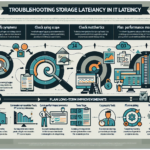Resolving replication issues between multiple Active Directory (AD) domain controllers is critical to ensure the integrity and availability of your directory services. Here’s a step-by-step guide:
1. Identify the Issue
Start by determining the scope and specifics of the replication problem.
- Tools to Use:
- Event Viewer: Check for errors or warnings related to replication (e.g., Event ID 1864, 2103, or 1084).
- Active Directory Replication Status Tool (ADREPLSTATUS): Microsoft’s free tool for diagnosing replication issues.
- Repadmin: Use the
repadmin /replsummarycommand to get a summary of replication status across domain controllers.
2. Verify Network Connectivity
Replication requires stable network communication between domain controllers.
- Steps:
- Ping the affected domain controllers to ensure they are reachable.
- Check DNS resolution for domain controller names (
nslookup <dc-name>). - Confirm that ports required for replication (e.g., 135, 445, 389, 636) are open between the domain controllers.
3. Check Time Synchronization
Kerberos authentication relies on synchronized clocks. If time is out of sync, replication may fail.
- Steps:
- Use the
w32tm /query /statuscommand to check time settings on domain controllers. - Ensure the PDC Emulator in the forest root domain is synchronizing with an external time source, and other domain controllers are synchronizing with the PDC Emulator.
4. Verify DNS Configuration
Active Directory heavily depends on DNS for replication.
- Steps:
- Confirm that each domain controller has the correct DNS settings (typically pointing to itself and other DCs as secondary).
- Use
dcdiag /test:dnsto check DNS health. - Ensure SRV records (e.g., _ldap._tcp) exist for the affected domain controllers.
5. Use Repadmin for Diagnostics
Repadmin is a powerful command-line tool for troubleshooting AD replication.
- Useful Commands:
repadmin /showrepl: Displays replication status for all domain controllers.repadmin /showconn: Shows connection objects between domain controllers.repadmin /syncall: Forces synchronization across all domain controllers.repadmin /queue: Displays replication requests in the queue.
6. Check the AD Database (NTDS)
Corruption in the AD database can cause replication issues.
- Steps:
- Run
dcdiag /test:replicationsto check replication health. - Examine the NTDS logs in Event Viewer.
- If corruption is suspected, restore from a backup or use the
ntdsutiltool for repairs.
7. Resolve Stale or Lingering Objects
Lingering objects can occur if a domain controller was offline for an extended period.
- Steps:
- Use
repadmin /removelingeringobjectsto clean up lingering objects. - Ensure tombstone lifetime is appropriately configured (default: 180 days).
8. Check AD Site and Replication Topology
Misconfigurations in the site or replication topology can cause issues.
- Steps:
- Use Active Directory Sites and Services to verify site links, subnets, and replication schedules.
- Use
repadmin /kccto force the Knowledge Consistency Checker (KCC) to rebuild the replication topology.
9. Verify Security Permissions
Replication can fail if permissions are misconfigured.
- Steps:
- Ensure the Domain Controllers group has the necessary permissions for replication.
- Check for any Group Policy settings that might block replication traffic.
10. Restart AD Services
Sometimes, restarting services can resolve transient issues.
- Steps:
- Restart the
Active Directory Domain Servicesservice on the affected domain controllers. - Run
net stop ntfrsfollowed bynet start ntfrsif using File Replication Service (FRS).
11. Monitor and Test Replication
After making adjustments, verify that replication is functioning correctly.
- Steps:
- Use
repadmin /syncallto manually trigger replication. - Use
dcdiag /test:replicationsto confirm replication health.
12. Escalate or Restore from Backup
If the issue persists, consider escalating to Microsoft support or restoring the affected domain controller from a backup.
Best Practices to Prevent Replication Issues
- Regularly monitor replication health using automated tools.
- Ensure all domain controllers are updated with the latest patches.
- Periodically test backups and disaster recovery procedures.
- Properly configure sites, subnets, and site links for optimal replication.
Following these steps should help you identify and resolve replication issues between multiple Active Directory domain controllers effectively. Let me know if you need further assistance!



